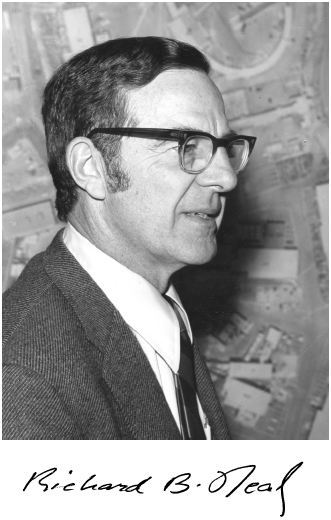
1917–2012
Elected in 1979
“For leadership in the design and construction of multi-GeV linear electron accelerators.”
BY GREGORY LOEW SUBMITTED BY THE NAE HOME SECRETARY
RICHARD BARR NEAL, a key figure in the design, construction, and operation of the Stanford Linear Accelerator Center, died on November 22, 2012, in Solana Beach, California, at age 95.
Richard Neal was born on September 5, 1917, in Lawrenceburg, Tennessee, a small town 80 miles south of Nashville. After education in local schools, he attended the US Naval Academy in Annapolis, Maryland, where he excelled in track events and played football before graduating in 1939. He then served two years aboard the battleship USS Pennsylvania until his discharge in 1941 because of a defect in his eyesight.
He accepted a position as a field service engineering supervisor for New York–based Sperry Gyroscope Co., which at the time was involved in high-power microwave research, including the development of the first klystron designed at Stanford University. Klystrons later became the microwave power sources to accelerate electrons in linear accelerators.
In 1944, Neal and Gail Annette Nesbitt were married at Forest Hills Gardens, Long Island, New York, where they resided for the next three years.
After working on rocketry systems for Sperry at the close of the war, he left to attend Stanford as a graduate student in 1947. In this capacity he worked on the development of
many systems and components needed for linear electron accelerators at Stanford, and in 1953 he published his doctoral thesis, a voluminous technical report about Stanford’s 220-foot-long Mark III accelerator project, a precursor to the 2-mile-long accelerator. He became a physics research associate at Stanford in 1951.
As a result of the success of the Mark III machine as a physics research tool, Neal became part of a small group of visionaries who started meeting in 1956 in the home of Wolfgang “Pief” Panofsky, who would later become SLAC’s first director, to discuss preliminary plans for building a much larger electron linear accelerator, then dubbed “Project M” (the “M” affectionately stood for “monster” because of its scale). The group submitted a proposal in 1957 to several US government agencies to build such a machine on Stanford-owned land. After several years of negotiations, the project was finally approved for construction by the US Atomic Energy Commission in 1961. The Stanford University Board of Trustees named it the Stanford Linear Accelerator Center (SLAC).
At this point, Neal was appointed associate director of SLAC and became the leader of its technical division, which grew to a staff of nearly 600 physicists, engineers, technicians, and support staff. Under Panofsky’s and Neal’s leadership, construction of the center was completed successfully in 1966 within schedule and budget ($114 million). Neal was also selected as a member of the SLAC faculty, a group of professors responsible for steering and discussing the ongoing and future intellectual and scientific programs of the laboratory.
Neal was a superb technical writer, always attentive to detail and style. He chronicled the entire design, construction, and early operation of the project as the lead author of a 1,169-page work, The Stanford Two-Mile Accelerator (also known as “The Blue Book”). It is a lasting tribute and valuable reference for the innovations and expertise in technology and engineering brought to bear in constructing the linear accelerator, which continues to power cutting-edge research.
Neal remained head of the SLAC technical division until 1982. During his tenure, SLAC saw many new developments,
a gradual increase in the electron and positron beam energies through the construction of more powerful klystrons; the invention of a microwave energy storage cavity system called SLED (SLAC Energy Development); the construction of two successive electron-positron colliding beam rings, SPEAR and PEP; and the award of Nobel prizes to SLAC physicists Burton Richter and Martin Perl. Richard Taylor later received a Nobel for research conducted during Neal’s time at the lab. During all these years, Neal was recognized as an excellent leader and manager. An extremely hard worker, he truly led by example and was highly respected by Panofsky and other colleagues and staff.
Neal was also renowned in the physics and accelerator community at large. During his career he authored more than 100 reports and technical papers, contributed to several books, and participated in numerous national and international committees and conferences related to accelerators. He was a fellow of the American Physical Society, a member of the scientific research society, Sigma Xi, and in 1979 was elected to the National Academy of Engineering.
Before retiring from SLAC in 1985, Neal had taken up flying as a hobby, obtained a pilot’s license, and would on occasion fly over the lab. His hobbies also included ballroom dancing, ice skating, cycling, hiking, music, reading, and spectator sports.
After his retirement, Neal, his wife, and daughter Martha moved to a residential community in Solana Beach in Southern California. He became a member of the board of directors of the homeowners association, and as secretary and treasurer he put great emphasis on achieving a firm financial foundation for the association, very much in tune with the way he had managed financial affairs at SLAC.
When Neal turned 80, he returned to SLAC for a 1997 symposium honoring him on this milestone birthday. The symposium was a wonderful occasion to celebrate his many SLAC accomplishments and for colleagues and physicists from all over the country to see him once more and to look into the future of the scientific field he served so well.
Richard Neal is survived by his wife of 68 years, Gail, daughter Martha (Marti) Neal of Solana Beach, and son Richard Forrest Neal of Bonny Doon, California. If you ever visit SLAC and stand in front of Building 41 where he had his office, you will see the silk tree (Albizia julibrissin) he planted to commemorate his retirement in 1982.






